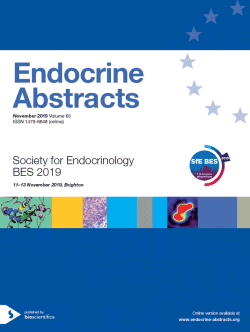
Society for Endocrinology BES 2019
Brighton,
United Kingdom
11 Nov 2019 - 13 Nov 2019

ORAL COMMUNICATIONS
Bone and Calcium
ea0065oc3.1 | Bone and Calcium | SFEBES2019
A mouse model generated by CRISPR-Cas9 with a frameshift mutation in the nuclear factor 1/X (NFIX) gene has phenotypic features reported in Marshall-Smith Syndrome (MSS) patients
Kooblall Kreepa , Stevenson Mark , Stewart Michelle , Szoke-Kovacs Zsombor , Hough Tertius , Leng Houfu , Horwood Nicole , Vincent Tonia , Hennekam Raoul , Potter Paul , Cox Roger , Brown Stephen , Wells Sara , Teboul Lydia , Thakker Rajesh
ea0065oc3.2 | Bone and Calcium | SFEBES2019
Hypophosphatasia in adulthood - are patients really ‘unaffected’
Chong Zhuo Min , Toellner Hannah , Sainsbury Christopher AR , Srivastava Rajeev , Gallacher Stephen J , Ahmed Syed Faisal
ea0065oc3.3 | Bone and Calcium | SFEBES2019
Generation of a long acting parathyroid hormone hybrid analogue through fusion to a binding protein
Sorour Lina , Ross Richard J , Wilkinson Ian R
ea0065oc3.4 | Bone and Calcium | SFEBES2019
Characterisation of rare GNA11 variants reveals 8 novel residues important for signalling by the calcium-sensing receptor: Relevance for FHH and ADH
Gluck Anna , Lines Kate , Gorvin Caroline , Inoue Asuka , Hannan Fadil , Breitwieser Gerda , Thakker Rajesh
ea0065oc3.5 | Bone and Calcium | SFEBES2019
Mutational analysis of a patient with familial hypocalciuric hypercalcaemia identifies a novel p.Ser182Cys mutation, which is predicted to disrupt the calcium sensing receptor (CaSR) extracellular domain
Healy Ultan , Olesen Mie Kronborg , Jafar-Mohammadi Bahram , Hannan Fadil M , Thakker Rajesh V
ea0065oc3.6 | Bone and Calcium | SFEBES2019
The role of biased calcium-sensing receptor signalling in urinary calcium excretion and kidney stone disease
Goldsworthy Michelle , Bayliss Asha , Gluck Anna , Wiberg Akira , Turney Benjamin , Furniss Dominic , Thakker Rajesh , Howles Sarah



